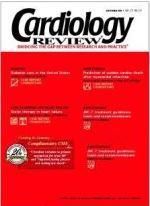Publication
Article
Cardiology Review® Online
High-density lipoprotein cholesterol and endothelial function
The study by Kuvin and Karas (page 42) showed a significant correlation between vascular endo-
thelial function and high-density lipoprotein (HDL) cholesterol level, which was detected by flow-mediated dilation of the brachial artery using ultrasonography. A multivariate analysis revealed HDL cholesterol was an independent predictor of flow-mediated dilation. This finding adds to the increasing literature about the importance of modulating HDL cholesterol. It also shows the role of this lipoprotein in the development of atherosclerosis, a diffuse disease characterized by anatomic and physiologic abnormalities of the blood vessels.
The vascular endothelium plays a significant role in atherosclerosis by affecting vasomotor tone, thrombosis, and platelet function. HDL cholesterol consists of a heterogeneous class of lipoproteins, including apolipoprotein (apo) A-I as a major component, apo A-II, apo C, apo E, lecithin-cholesterol acyltransferase, paraoxonase, and platelet-activating factor, all of which impart significant physiologic functions.1
Protective effect of HDL
cholesterol
A growing body of literature is focusing on the protective effect of HDL cholesterol on the atherosclerotic process by virtue of its effects on endothelial function. Endothelial dysfunction has been reported in patients with primary hypoalphalipoproteinemia, a genetic disorder characterized by low plasma HDL and apo A-I levels. A low HDL level has also been shown to be an independent predictor of endothelial dysfunction in healthy, diabetic, and dyslipidemic patients.2
Incubation of cultured endothelial cells with HDL activates nitric oxide synthase in a process that involves the binding of scavenger receptor-
BI to apo A-I. The new complex
HDL scavenger receptor-BI protects against atherosclerosis, and overexpression of scavenger receptor-BI in the liver reduced atherosclerosis in several murine models.3,4 Incubation of cultured endothelial cells with HDL cholesterol has been shown to cause dose-dependent increases in prostacyclin—a potent endothelium-derived vasodilator—and prevents the vasoconstrictor effects of endothelin-1—a potent endothelium-derived vasoconstrictor.
HDL cholesterol has also been shown to down-regulate tumor necrosis factor-induced cell adhesion molecule expression in vitro in a dose-dependent manner. This prevents inflammatory cells from adhering to the endothelial surface and subsequently transmigrating into the intimal tissue.
In vitro, HDL cholesterol also inhibits (in a dose-dependent manner) the production of platelet-activating factor, which is responsible for stimulation of cell adhesion, vascular permeability, platelet aggregation, and smooth muscle contractility. There is an inverse correlation of plasma HDL and circulating von Willebrand factor (essential for platelet adhesion and aggregation), which is secreted by the endothelial cells, suggesting a possible inhibitory role of HDL cholesterol in its production. In vitro, HDL cholesterol has also been shown to enhance endothelial cell migration. This is a critical process that leads to endothelial regeneration after an injury.
The atheroprotective activity of HDL cholesterol can also be explained by the unique ability of these lipoproteins to remove cholesterol from the arterial wall and transport it to the liver for biliary excretion, known as reverse cholesterol transport. Finally, oxidized low-density lipoprotein (LDL) cholesterol is known to be a potent inducer of endothelial dysfunction, and there is evidence that its deleterious effects can be counteracted by HDL cholesterol and its associated particles, such as paraoxonase, lecithin-cholesterol acyltransferase, and platelet-activating factor.5
Clinical implications
Traditionally, lipid management in patients with atherosclerosis has focused on LDL reduction; however, clinical evidence regarding the benefits of HDL modulation is emerging. It is becoming evident that patients with low HDL cholesterol should be treated more aggressively with lifestyle modifications, including increased physical activity and decreased saturated fat intake. They should also receive agents that raise HDL cholesterol, such as niacin, fibrates, or a combination of niacin and a statin. All of these therapies have shown positive clinical results.
Patients treated with niacin and simvastatin combination showed significantly slowed progression of coronary stenosis (—0.4% versus 3.9%; P < .01) and reduced frequency of a first cardiovascular event (3% versus 24%; P < .001) compared with the placebo group.6 Another study suggested that infusion of reconstituted HDL cholesterol leads to a significant improvement in endothelial function in hypercholesterolemic men.7 This therapy increased plasma HDL cholesterol, enhanced the acetylcholine-induced increase in forearm blood flow, and improved flow-mediated dilation of the brachial artery.
A study by Nissen and colleagues showed that intravenous infusion of recombinant apo A-I Milano-phospholipids complex for 5 weeks led to a 4% decrease in coronary plaque volume from baseline in patients with recent acute coronary syndromes.8 Larger clinical studies, further elucidating the importance of HDL cholesterol modulation in atherosclerosis, are needed and should help corroborate the beneficial effects observed with these lipoproteins in basic science laboratories.






